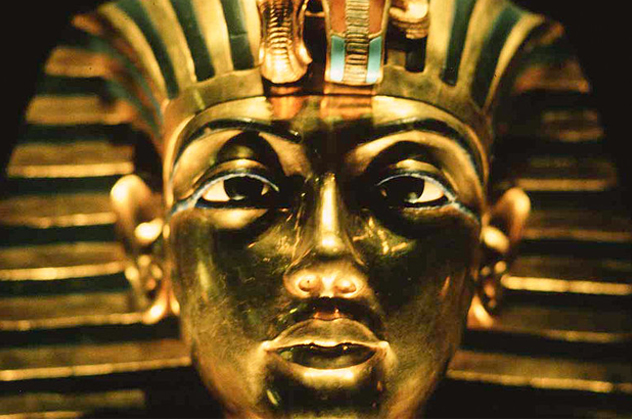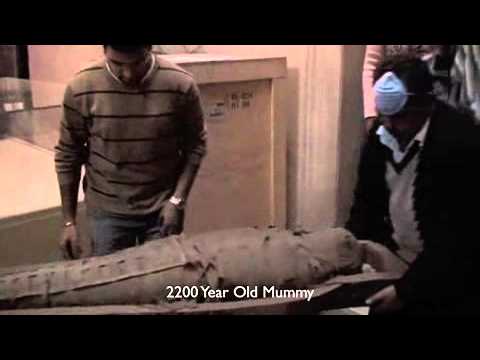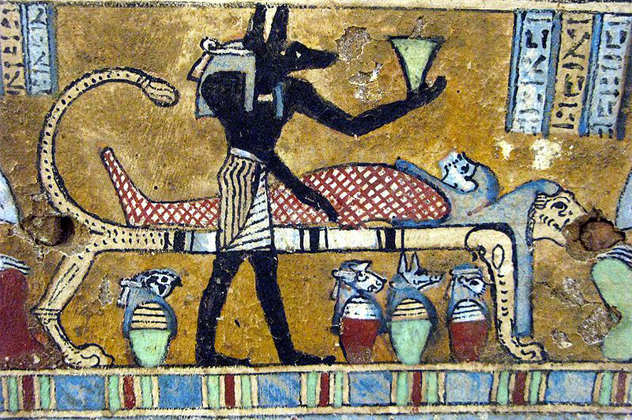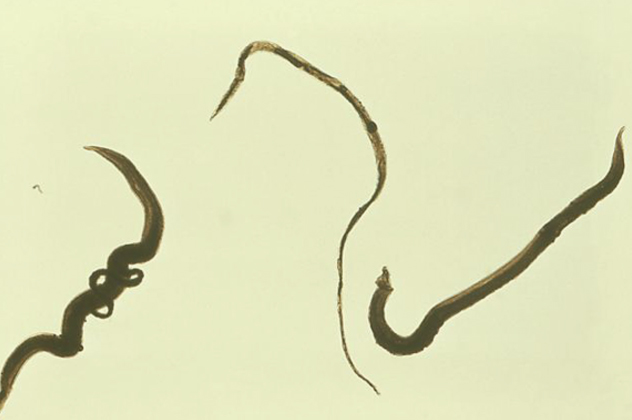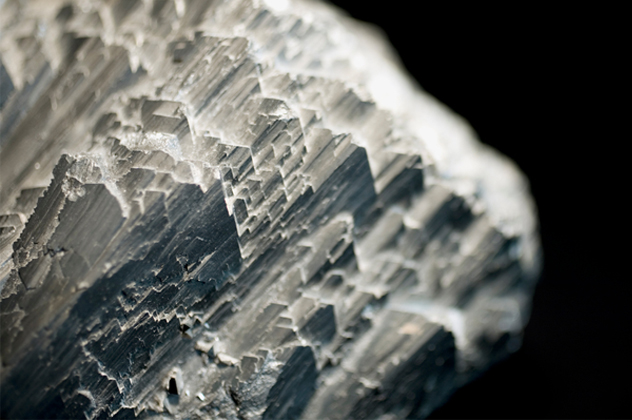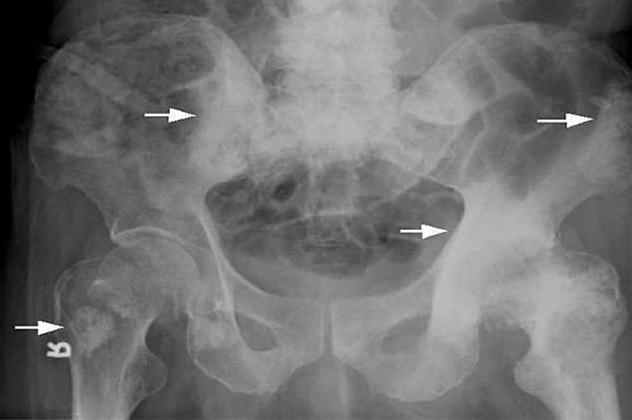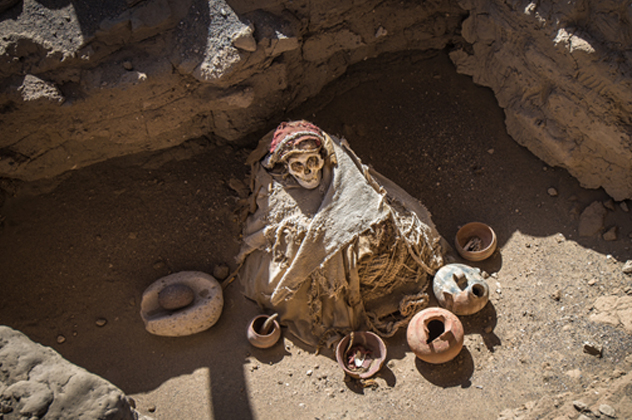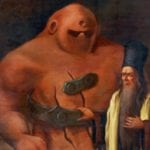10An Erect Penis
Many people know Tutankhamun, or King Tut, as the boy-king who became pharaoh at the age of 10. What most people don’t know is that he was mummified with an erect penis. Aside from that, King Tut’s mummy has other anomalies. The young pharaoh’s heart or heart scarab (a replacement artifact) was missing, and his body and coffin were covered in black liquid. Obviously, King Tut didn’t die with an erection. If he did, it would have died off immediately. Instead, his embalmers deliberately positioned his penis at a 90 degree angle. According to Salima Ikram of the American University in Cairo, there’s a religious explanation for King Tut’s mummified erection. She suggested that the erect penis was a deliberate attempt to make King Tut appear as Osiris, god of the Underworld. The erect penis is a symbol of Osiris’ regenerative powers. Ikram speculated that King Tut wanted to undo the religious revolution started by his father, Akhenaten. Akhenaten wanted Egypt to focus on the worship of the Aten or the sun disc. He was so ardent with his religious revolution that he went as far as destroying the images of other Egyptian deities. By appearing as Osiris in the most literal way possible, King Tut was giving Egypt back to all the gods.
9Colon Cancer
Colon cancer is the third most common type of cancer. It’s primarily caused by an unhealthy lifestyle, such as not exercising regularly, eating too much, and consuming processed foods. Since these factors are associated with today’s lifestyle, many people have assumed that colon cancer is pretty modern. However, a study involving Hungarian mummies from the 17th and 18th centuries shows that the disease also plagued the people of that era. The tissue samples used in the study were collected from 20 mummies that were discovered in sealed crypts in Vac, Hungary. This archaeological find is remarkable since it proves that colon cancer predates our modern impacts on health. Hopefully, it will help medical experts have a better understanding the disease, and what causes it.
8Dirt
After performing a CT scan on a 3,200-year-old Egyptian mummy, Jonathan Elias from the Akhmin Mummy Studies Consortium discovered dirt inside the mummy’s head. The researcher also discovered that the individual’s brain had remained untouched during the mummification process, leaving it intact inside the skull. Elias’s findings led him to assume that the mummy lived between the 16th and 11th centuries BC or during the age of the New Kingdom. After that period, it became a standard procedure to remove the brains during mummification. This mummy, Hatason, is one of the few samples from the New Kingdom period, making it a significant source of knowledge. After analyzing the shape of Hatason’s skull, Elias postulated that she was a woman. Typically, experts would use the mummy’s pelvis to determine the gender. In this case, the pelvis had collapsed, leaving Elias to make the assumption solely based on the shape of her skull. As for the dirt, it remains a mystery. It is a mummification method not seen in other Egyptian mummies. Experts are still at loss as to its real function. The best guess is that they were trying out different mummification techniques during that time.
7Clogged Arteries
Atherosclerosis is a serious condition where plaques build up in the arteries, causing them to become hardened and narrowed. It can lead to strokes, heart attacks, and other cardiovascular diseases. It’s the leading cause of death in first world countries. It’s assumed in order to prevent atherosclerosis, we must adapt the hunter-gatherer lifestyle of our ancient ancestors. We need a lifestyle full of physical activity and a diet rich in protein and unsaturated fats free from processed foods. However, a study involving 137 mummies shows that this long-held assumption is not the truth. Greg Thomas from the University of California, Irvine and his team performed CT scans on more than 100 mummies. These mummies came from four different ancient groups of people—Peruvian, Egyptians, Unangans, and Ancestral Puebloans. The scientists discovered that 34 percent or 47 of the 137 mummies had clogged arteries. What’s more, the disease was just as bad back then as it is today. Scientists are quite shocked since these ancient civilizations were around in what is considered the epitome of healthy living.
6Brain-Removal Tool
Around 3,500 years ago, the Egyptian mummification process took a significant turn. This is when embalmers started removing the brains before the individuals were mummified. To do this, the embalmers would use primitive brain removal tools. Unfortunately, some of them were a bit careless and left tools lodged inside the skulls of their dead subjects. In 2008, a group of scientists from Croatia performed a series of CT scans on a 2,400-year-old female mummy. Much to their surprise, a brain-removal tool was found between her left parietal bone and the back of her skull. In fact, cases like this are extremely rare as only two have ever been found. The other brain-removal tool was found inside the head of a 2,200-year-old mummy. The object was seven centimeters (3 in) long, and it was made from an organic material. The researchers suspect that the original tool might have been longer, and that their finding was just the tip. They assume that the tool broke during the mummification process. Since retrieving it would have been tedious, the embalmers just decided to leave it inside the skull.
5S. Mansoni
Every year, 200 million people around the world are infected with schistosomiasis, a disease that can damage the bladder, liver, lungs, and intestines. The worms that cause this disease live in both stagnant and flowing water. They enter the human body by coming into contact with the skin. There’s really nothing interesting about schistosomiasis except for the fact that S. mansoni, a type of worm that causes the disease, has been discovered in ancient Nubian mummies. It was first thought that S. mansoni was a more modern disease linked to urban living. The fact that this worm was found in Nubian mummies proves that it has plagued mankind since ancient days. The study was conducted by researchers from Emory University and involved 191 mummies from two distinct Nubian populations—Kulubnarti and Wadi Halfa. Both groups were infected with S. mansoni.
4Arsenic
For thousands of years, the ancient people of northern Chile were exposed to significant levels of arsenic. This was the result that the researchers from Chile’s Universidad de Tarapaca received by hair analysis on 45 Andean mummies that were discovered in the Atacama desert region. Arsenic is a tasteless, colorless and odorless substance found in ground water and contaminated rivers. Unfortunately for the ancient civilization, this poison was abundant in the Atacama coastal desert region. Chronic exposure to this substance can lead to skin diseases, neurological problems, premature birth, cancer, and ultimately death. After conducting a thorough analysis, researchers discovered that 31 percent of the mummies had arsenic levels of 2.6 micrograms per liter. Over time, the ancient people of northern Chile accumulated significant levels of arsenic and ultimately suffered the poison’s effects.
3Prostate Cancer
Thanks to high-resolution CT scanners, scientists are learning a lot about the diseases that plagued ancient civilizations. In fact, they were able to identify prostate cancer in a 2,250-year-old Egyptian mummy with the use of this invaluable equipment. The prostate cancer found in the mummy, named M1, is considered to be the oldest known case from ancient Egypt and the second oldest in the world. The 2,700-year-old remains of a Scythian king from Russia claims the title for the oldest known case of this deadly disease. After performing the CT scans on M1, a team of scientists discovered tumors in the mummy’s legs, upper arm, lumbar spine, and pelvis. This finding led to the conclusion that M1 suffered from metastatic prostate cancer before his death around 51 to 60 years old. This discovery only proves once again that cancer isn’t as new as we thought, and it has been plaguing mankind for centuries.
2Well-Preserved Brain
In August 2010, Russian scientists discovered the mummy of a woolly mammoth believed to be 39,000 years old. The mummified animal was discovered in the Siberian permafrost. Aside from the fact that the mammoth’s body was so well-preserved, it’s brain was in excellent condition. In fact, it’s the most intact mammoth brain known to science. After studying Yuka, the mummified animal, experts concluded it died between the age of six and nine. With the help of CT scanners, the researchers were able to find nervous tissue—the main component of the nervous system—and study the animal’s cerebrum and cerebellum. Unfortunately, the mammoth’s forebrain was in bad condition. However, thanks to Yuka, scientists now have the opportunity to examine a woolly mammoth’s brain. Surprisingly, they have found to be quite similar to that of modern-day elephants.
1Antibiotic-Resistant Genes
Antibiotic abuse is common nowadays. In fact, it’s a growing problem. It’s obviously dangerous since the overuse of antibiotics can lead to serious health problems and the development of super bugs. For years, antibiotic resistance has been associated with antibiotic abuse. However, studies from an 11th century mummy show that the “gene mutations responsible for antibiotic resistance occurred naturally in 1,000-year-old bacteria and are not necessarily linked to the overuse of antibiotics.” The mummy was a woman who died between the age of 18 and 23, and was discovered in Cuzco, the capital of the ancient Inca empire. Her body was arranged in a fetal position and was wrapped in baskets. Only her head and hands were visible. After analyzing the microbiome in the mummy’s gut, the researchers discovered several antibiotic-resistant genes in her body. If she was alive today, most of our antibiotics, such as tetracycline, vancomycin and chloramphenicol, wouldn’t have been able to save her. Paul Jongko is an experienced freelance writer who spends his time writing interesting stuff and creating piano covers. To hire him for your writing projects, contact him by email here. Read More: Twitter MeBook
